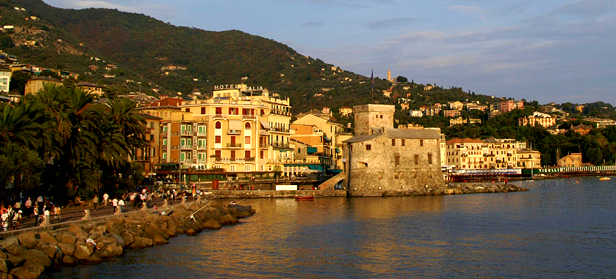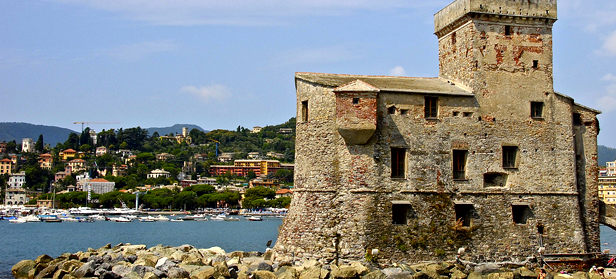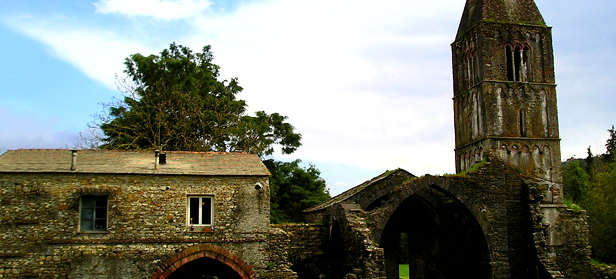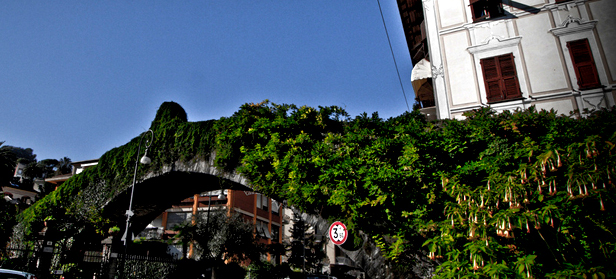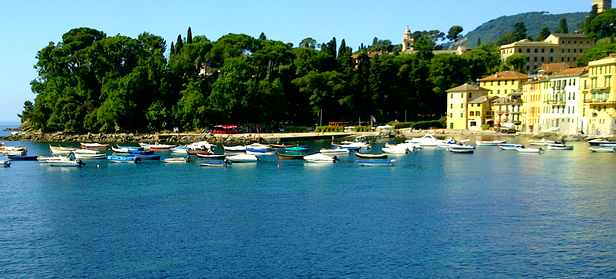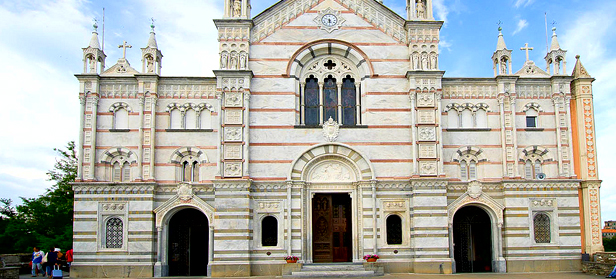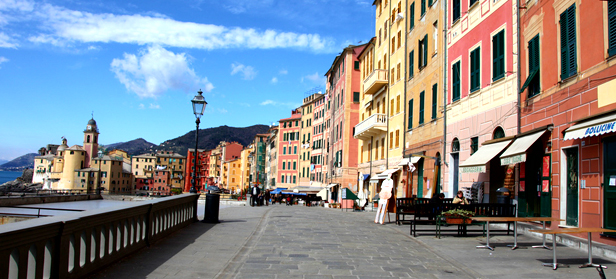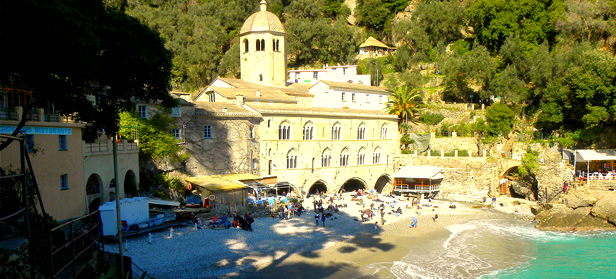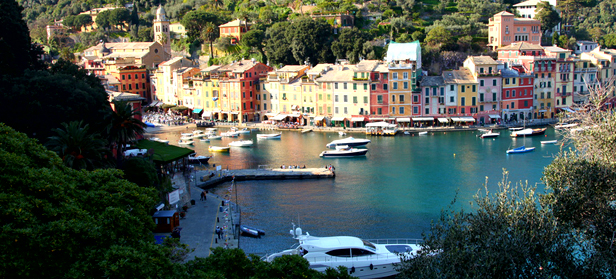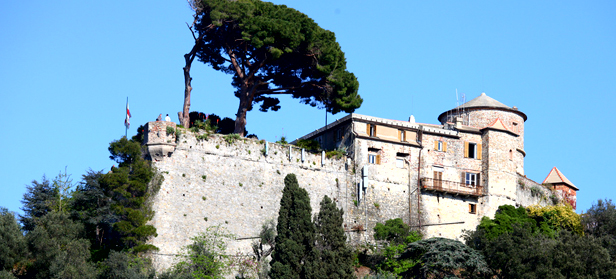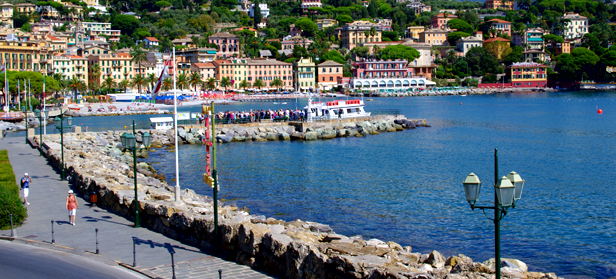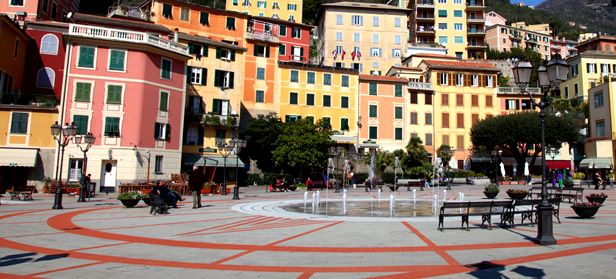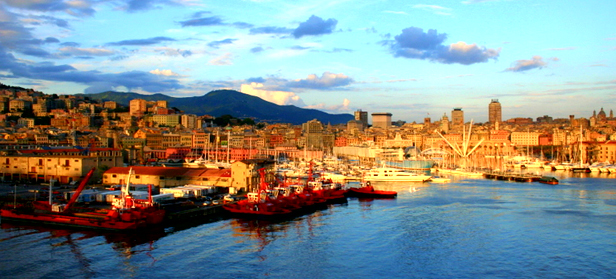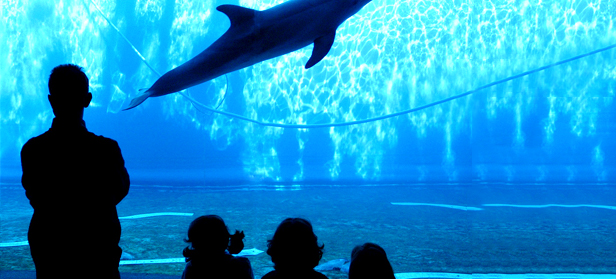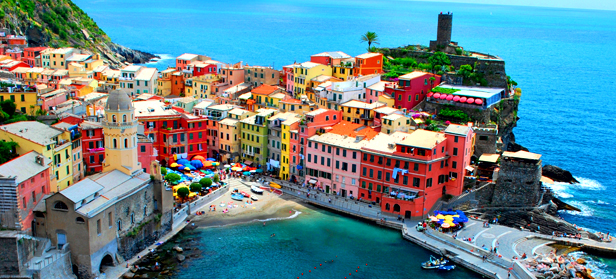RapalloIt is one of the great centres in the Riviera di Levante, laying in an inlet on the Tigullio gulf, protected from the winds and the streams: a happy site for its climate and the natural beauties, once inhabited, in pre-roman epoch, by the Liguri Tigulli.Rapallo is one of the preferred destinations of international tourism and important cultural events take place in Rapallo, like the national literay award for women writers and the international cartoonist exhibition.Near the bathing establishments there are two tourist small ports for about 900 boats. The ex Clarisse nunnery, today an auditorium, is only one of the prestigious structures for congresses and conventions, not to mention the sea promenade with its famous cafés and dehors.The sport facilites are of high quality: the olympic swimming pool, the horse-riding club, the minigolf course and the target-shooting. The 18 holes golf course is one of the most renowned in Italy.The Sanctuary of Montallegro is the most important centre of devotion in the Tigullio, celebrated in July with a patronal feast known everywhere for its fireworks. It can be reached by a confortable cableway. But very attractive is also the pathfoot to the Sanctuary or the one to San Fruttuoso. Other typical paths climb the hills facing the sea, like those in the Park of the Mount of Portofino characterised by the mediterranean flora: olive trees, holm-oaks, brooms and chestnut-trees. |
Rapallo – The Ancient CastleIt is the symbol of Rapallo, built in 1550 by the architect Antonio Carabo, after the decision of the genoese Senate in consideration of the assault and the sack of the town on the 4th of July of the previous year, by the barbarian fleet of Torghu, known as “Dragutte”. |
Rapallo -The Feast of The 1st – 2nd and 3 of JulyIt is the most felt festivity in Rapallo, dedicated to the Madonna di Montallegro, from the picture you can get an idea of the fireworks typical of this feast. |
Rapallo -The Monastry of Valle ChristiSituated in the small plane under the village of San Massimo, the monastry was founded in 1204 thanks to the initiative of two genoese ladies.At the beginning the monastry sheltered the cistercian order nuns, later the agostinian nuns. It was closed after the bull of Pope Pio V, on October 3, 1568.Today you can only visit the ruins of the romanic belltower, the church apses and the two side-chapels, the ruins of the walls, which, in accordance with the Cistercian severity have no decorations and still witness the imponence of the site. |
Rapallo – The ancient Bridge called “Hannibal’s bridge”The ancient stone bridge, upcrossing the road to Santa Margherita Ligure, is in itself a confirmation of how easily a legend can be transformed into a fact. We are talking about the legend of Hannibal, a suggestive invention.Only supported by the hystoric fact, extremely fragile, that Hannibal and his army crossed the Alps in 218 b.c., after the Second Punic War, but probably never reached the Ligurian Coast and certainly they did not build the bridge. Actually, despite the imponence of the stone bridge, it was built with the purpose to join the ancient “pagus” of Rapallo and the “vici” of Pagana, Pescino and Porto Delfino.This romanesque bridge was built in the Upper Middle Ages to cross the River Boate. In 1823 the river was diverted to buils the street and the legend of Hannibal started to circulate. |
Rapallo – San Michele di PaganaLeaving Rapallo, by feet or by bus or car, there’s the fascinating small gulf of S. Michele with its villas, the bell tower and the church with a Van Dyck valuable painting. The small village lyes on the crystal clear waters of the sea. |
Rapallo – The Sanctuary of MontallegroIn the homonymous hamlet on the hills over the Tigullio Gulf, it is the most important centre of devotion. You can reach it by a comfortable cableway.The worship of the Madonna of Montallegro dates back to 1557, when a farmer stated the Virgin Mary app4eared to him and asked him to build a sanctuary in that place. |
CamogliA famous fishermen’s village situated at the centre of the Golfo Paradiso and sheltered by the promontory of Portofino. the Village has been practically the same for centuries with its characteristic high buildings in vivid colours built side by side and the small dark streets climbing the hill. the village ows its name “house of the wives” to the ancient habit according to which males were always away on the sea. its medieval centre, characterized by upgoing small streets, stairs and porticos, descends to the little port, still today shelter for fishermen’s boats. |
San Fruttuoso di CamogliThe millenary Abbey of San Fruttuoso of Capodimonte was edificated at the end of the XIII century and has been recently restored.The complex includes the whole monastic unit: the church, the cloister and the tombs of the Doria Family. these characteristic tombs have a gotic arc structure alternating white marble and grey slate.The whole unit is dominated by the Doria Tower, built in 1562 to defend the village from barbarian incursions.In the waters in front of the Abbey, 17 metres deep, one can admire the statue of the Christ in the Abyss, a classic dive for amateurs. |
PortofinoA village of roman origin (Portus Delphini, name due to the great number of dolphins in the bay), in the Middle Ages the importance of Portofino grew thanks to its natural port, a precious shelter for the vessels of those times.In order to appreciate the beauty and exceptionality of Portofino, it is important to admire it from the small square in front of the Church of San Giorgio: from the site you overlook the port and the string of coloured houses with the characteristic decorations.The tourist port, with 300 berths, has sheltered thre most famous boats in the world, still being an exclusive small port.The famous “Piazzetta”, surrounded by small houses and typical ogive archs, is renowned for its elegant boutiques, the american bars and restaurants. The name “Pearl of the world” is completely appropriated. Portofino is visited by hundred of tourists all over the year. |
Portofino – The Fortress of San Giorgio (Castello Brown)Built as a defence against attacks by Saracen pirates, it was re-built and enlarged in the 16th century by the Republic of Genoa, probably transformed into a hospital until the end of the 19th century when the British Consul Yeats Brown transformed it into a private residence. Since 1961 the castle is property of the Municipality of Portofino. |
Santa Margherita LigureSanta Margherita Ligure is a village of remote origins. The first document specifically mentioning the village is of the 12th century: it is mentioned as “Santa Margherita di Pescino”. In the following centuries we find two different villages, Pescino and Corte. The flourishing of Baroque, a high artistic moment in Liguria, has given the village remarkable monuments. The most famous, is Villa Centurione. Built immediately after 1560 by the Durazzo family, it is probably “signed” by the great architect Galeazzo Alessi. The villa is surrounded by a great park with Italian gardens. To the same epoch belongs the castle in front of the sea. Remarkable are also the churches, among which we mention S. Margherita di Antiochia, built in baroque style and which conserves inside masterpieces of genoese painters (De Ferrari, Castello, Ponsonelli, Carione). |
ZoagliZoagli lyes in a small bay among the cliffs between Rapallo end Chiavari. It was already inhabited in pre-roman times and was renowned in the Middle Ages for its silk and velvet crafts. During the Second World War Zoagli was repeatedly bombarded and, as a consequence, its orginal aspect has been partially ruined. |
GenovaGenoa, chief-town of Liguria, lyes on the coast of the Genoa Gulf between Voltri on the west and Nervi on the east. On the north there are the Polcevera and Bisagno valleys. Its inhabitants were, in 1999, more than 678,700. Its original nucleus, already existing in pre-roman times, developed around the so-called Mandraccio berth and the hill of Castello. During the 9th century the genoese population built the first defensive walls and prepared the ground for the development of maritime commerce which will give later to the Republic of Genoa power and wealth on the Mediterranean sea. At the beginnning of the 19th century great industrial complexes were built near the port. The historic centre of Genoa is one of the largest in Europe. |
Acquarium of GenoaA visit to the Aquarium of Genoa is like a thrilling journey through the vastity of the sea. A unique experience at the discovery of a universe rich of life, of curiosities and strange creatures. |
Cinque TerreFive miles of rocky coast in eastern Liguria, two promontories at each side, thousand kilometres of “muretti a secco” (typical walls made of small stones), five small villages typically built on the hill or lying in small inlets: these are the Cinque Terre.Since 1997 the territory is a National Park protected by the Unesco. This area is characterized by its narrow hillsides where olive trees are grown in a typical “terrace” way; a unique representation of the transformation man can impress on the land.The magnificent coast with high cliffs perpendicular to the sea, small bays, delicious beaches among the cliffs, deep clear waters with a great variety of fish, contribute to its fame of authentic natural “work of art”. |

